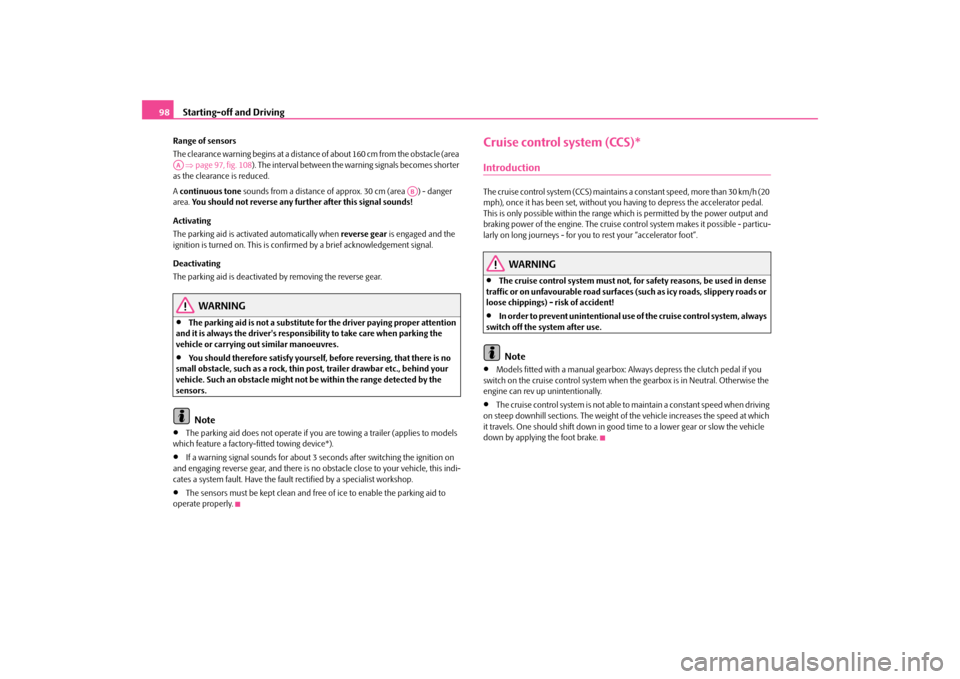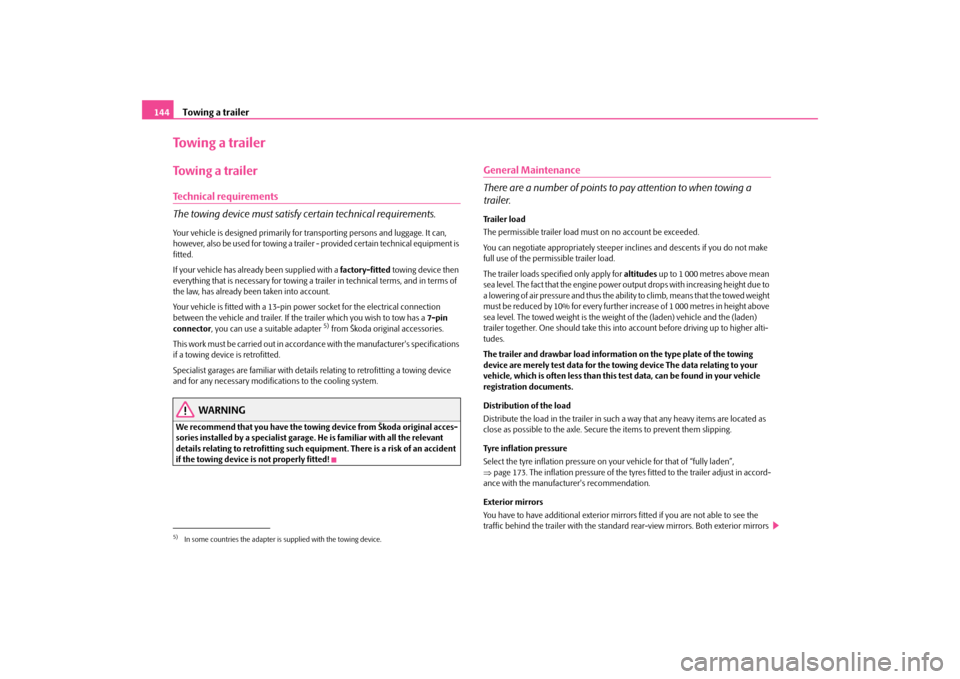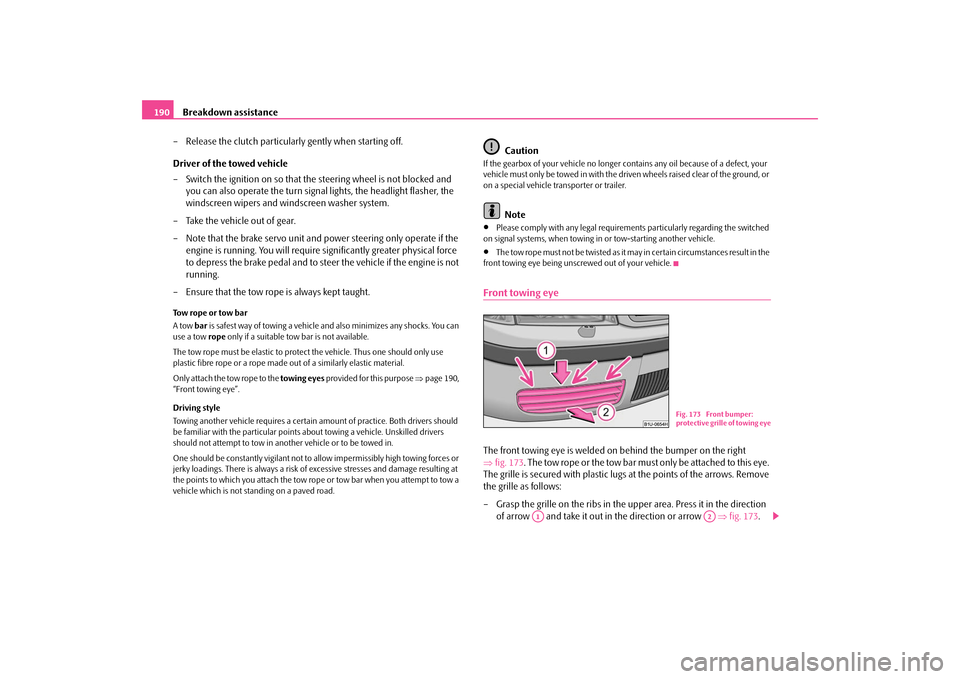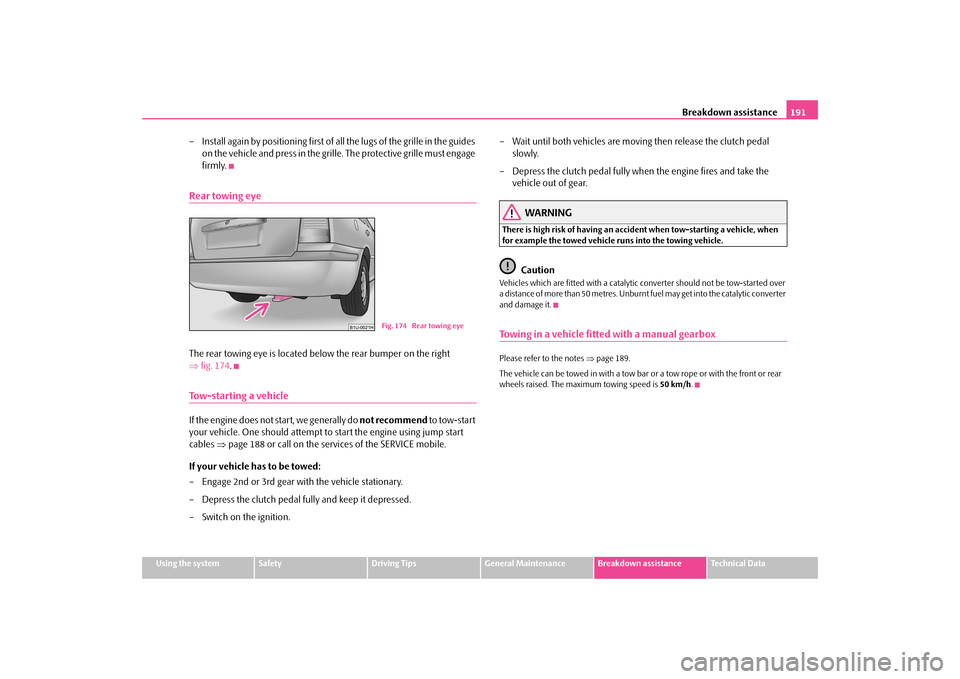tow bar SKODA OCTAVIA TOUR 2009 1.G / (1U) Owner's Manual
[x] Cancel search | Manufacturer: SKODA, Model Year: 2009, Model line: OCTAVIA TOUR, Model: SKODA OCTAVIA TOUR 2009 1.G / (1U)Pages: 224, PDF Size: 13.53 MB
Page 99 of 224

Starting-off and Driving
98
Range of sensors The clearance warning begins at a distance of about 160 cm from the obstacle (area ⇒page 97, fig. 108
). The interval between the warning signals becomes shorter
as the clearance is reduced. A continuous tone
sounds from a distance of approx. 30 cm (area ) - danger
area.
You should not reverse any further after this signal sounds!
Activating The parking aid is activated automatically when
reverse gear
is engaged and the
ignition is turned on. This is confir
med by a brief acknowledgement signal.
Deactivating The parking aid is deactivated by removing the reverse gear.
WARNING
•
The parking aid is not a substitute fo
r the driver paying proper attention
and it is always the driver's responsibility to take care when parking the vehicle or carrying ou
t similar manoeuvres.
•
You should therefore satisfy yourself, before reversing, that there is no
small obstacle, such as a rock, thin post, trailer drawbar etc., behind your vehicle. Such an obstacle might not be within the range detected by the sensors.
Note
•
The parking aid does not operate if you
are towing a trailer (applies to models
which feature a factory-fitted towing device*).•
If a warning signal sounds for about 3 seconds after switching the ignition on
and engaging reverse gear, and there is no ob
stacle close to your vehicle, this indi-
cates a system fault. Have the fault rectified by a specialist workshop.•
The sensors must be kept clean and free
of ice to enable the parking aid to
operate properly.
Cruise control system (CCS)*IntroductionThe cruise control system (CCS) maintains a constant speed, more than 30 km/h (20 mph), once it has been set, without you
having to depress the accelerator pedal.
This is only possible within the range wh
ich is permitted by
the power output and
braking power of the engine. The cruise control system makes it possible - particu- larly on long journeys - for you to rest your “accelerator foot”.
WARNING
•
The cruise control system must not, for safety reasons, be used in dense
traffic or on unfavourable road surfaces
(such as icy roads, slippery roads or
loose chippings) - risk of accident!•
In order to prevent unintentional use of
the cruise control system, always
switch off the system after use.
Note
•
Models fitted with a manual gearbox: Al
ways depress the clutch pedal if you
switch on the cruise control system when
the gearbox is in Neutral. Otherwise the
engine can rev up unintentionally.•
The cruise control system is not able to maintain a constant speed when driving
on steep downhill sections. The weight of the vehicle increases the speed at which it travels. One should shift down in good
time to a lower gear or slow the vehicle
down by applying the foot brake.
AA
AB
s2g8.b.book Page 98 Tuesday, April 7, 2009 8:53 AM
Page 145 of 224

Towing a trailer
144
Towing a trailerTo w i n g a t r a i l e rTechnical requirements The towing device must satisfy
certain technical requirements.
Your vehicle is designed primarily for tr
ansporting persons and luggage. It can,
however, also be used for towing a traile
r - provided certain te
chnical equipment is
fitted. If your vehicle has already been supplied with a
factory-fitted
towing device then
everything that is necessary
for towing a trailer in technical terms, and in terms of
the law, has already been taken into account. Your vehicle is fitted with a 13-pin po
wer socket for the electrical connection
between the vehicle and trailer. If th
e trailer which you wish to tow has a
7-pin
connector
, you can use a suitable adapter
5) from Škoda original accessories.
This work must be carried out in accordan
ce with the manufacturer's specifications
if a towing device is retrofitted. Specialist garages are familiar with details
relating to retrofitting a towing device
and for any necessary modifications to the cooling system.
WARNING
We recommend that you have the towing device from Škoda original acces-sories installed by a specialist garage.
He is familiar with all the relevant
details relating to retrofitting such equi
pment. There is a risk of an accident
if the towing device is not properly fitted!
General Maintenance There are a number of points to
pay attention to when towing a
trailer.Trailer load The permissible trailer load must
on no account be exceeded.
You can negotiate appropriatel
y steeper inclines and desc
ents if you do not make
full use of the perm
issible trailer load.
The trailer loads specified only apply for
altitudes
up to 1 000 metres above mean
sea level. The fact that the engine power ou
tput drops with increasing height due to
a lowering of air pressure and thus the abil
ity to climb, means that the towed weight
must be reduced by 10% for every further increase of 1 000 metres in height above sea level. The towed weight is the weight of the (laden) vehicle and the (laden) trailer together. One should take this into account before driving up to higher alti- tudes. The trailer and drawbar load information on the type plate of the towing device are merely test data for the tow
ing device The data relating to your
vehicle, which is often less than this test data, can be found in your vehicle registration documents. Distribution of the load Distribute the load in the trailer in such a way that any heavy items are located as close as possible to the axle. Secure
the items to prevent them slipping.
Tyre inflation pressure Select the tyre inflation pressure on your vehicle for that of “fully laden”, ⇒ page 173. The inflation pressure of the tyres fitted to the trailer adjust in accord- ance with the manufacturer's recommendation. Exterior mirrors You have to have additional
exterior mirrors fitted if you are not able to see the
traffic behind the trailer with the standard rear-view mirrors. Both exterior mirrors
5)In some countries the adapter is
supplied with the towing device.
s2g8.b.book Page 144 Tuesday, April 7, 2009 8:53 AM
Page 191 of 224

Breakdown assistance
190
– Release the clutch particular
ly gently when starting off.
Driver of the towed vehicle – Switch the ignition on so that the steering wheel is not blocked and
you can also operate the turn signal
lights, the headlight flasher, the
windscreen wipers and wi
ndscreen washer system.
– Take the vehicle out of gear. – Note that the brake servo unit and power steering only operate if the
engine is running. You will require si
gnificantly greater physical force
to depress the brake pedal and to steer the vehicle if the engine is not running.
– Ensure that the tow rope is always kept taught.Tow rope or tow bar A tow
bar
is safest way of towing a vehicle and also minimizes any shocks. You can
use a tow
rope
only if a suitable tow bar is not available.
The tow rope must be elastic to protect
the vehicle. Thus one should only use
plastic fibre rope or a rope made
out of a similarly elastic material.
Only attach the tow rope to the
towing eyes
provided for this purpose
⇒page 190,
“Front towing eye”. Driving style Towing another vehicle requires a certain
amount of practice. Both drivers should
be familiar with the particular points
about towing a vehicle. Unskilled drivers
should not attempt to tow in another vehicle or to be towed in. One should be constantly vigilant not to allow impermissibly high towing forces or jerky loadings. There is always a risk of excessive stresses and damage resulting at the points to which you attach the tow ro
pe or tow bar when you attempt to tow a
vehicle which is not standing on a paved road.
Caution
If the gearbox of your vehicle no longer
contains any oil because of a defect, your
vehicle must only be towed in with the driven wheels raised clear of the ground, or on a special vehicle transporter or trailer.
Note
•
Please comply with any legal requirements particularly regarding the switched
on signal systems, when towing in
or tow-starting another vehicle.
•
The tow rope must not be twisted as it may in certain circumstances result in the
front towing eye being unscrewed out of your vehicle.Front towing eyeThe front towing eye is welded on behind the bumper on the right ⇒
fig. 173
. The tow rope or the tow bar must only be attached to this eye.
The grille is secured with plastic lugs at the points of the arrows. Remove the grille as follows: – Grasp the grille on the ribs in the upper area. Press it in the direction
of arrow and take it out in the direction or arrow
⇒
fig. 173
.
Fig. 173 Front bumper: protective grille of towing eye
A1
A2
s2g8.b.book Page 190 Tuesday, April 7, 2009 8:53 AM
Page 192 of 224

Breakdown assistance
191
Using the system
Safety
Driving Tips
General Maintenance
Breakdown assistance
Technical Data
– Install again by positioning first of all the lugs of the grille in the guides
on the vehicle and press in the grille. The protective grille must engage firmly.
Rear towing eyeThe rear towing eye is located be
low the rear bumper on the right
⇒
fig. 174
.
Tow-starting a vehicleIf the engine does not start, we generally do
not
recommend
to tow-start
your vehicle. One should attempt to start the engine using jump start cables
⇒
page 188 or call on the servic
es of the SERVICE mobile.
If your vehicle has to be towed: – Engage 2nd or 3rd gear with the vehicle stationary. – Depress the clutch pedal fully and keep it depressed.– Switch on the ignition.
– Wait until both vehicles are movi
ng then release the clutch pedal
slowly.
– Depress the clutch pedal fully when the engine fires and take the
vehicle out of gear.
WARNING
There is high risk of having an accide
nt when tow-starting a vehicle, when
for example the towed vehicle runs into the towing vehicle.
Caution
Vehicles which are fitted with a catalytic
converter should not be tow-started over
a distance of more than 50 metres. Unburn
t fuel may get into the catalytic converter
and damage it.Towing in a vehicle fitted with a manual gearboxPlease refer to the notes
⇒page 189.
The vehicle can be towed in with a tow bar or a tow rope or with the front or rear wheels raised. The maximum towing speed is
50 km/h
.
Fig. 174 Rear towing eye
s2g8.b.book Page 191 Tuesday, April 7, 2009 8:53 AM